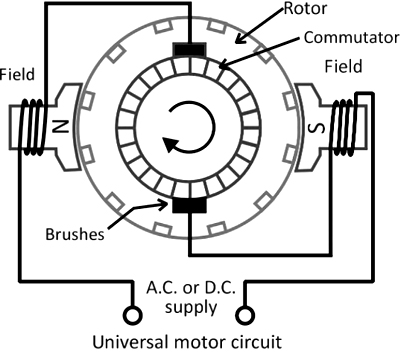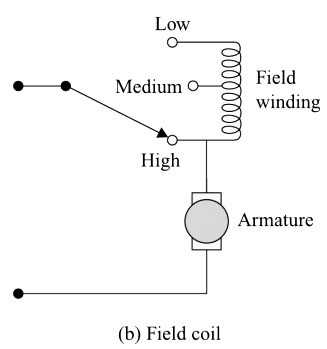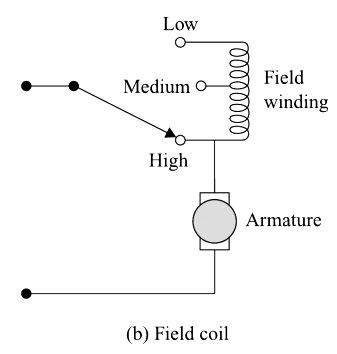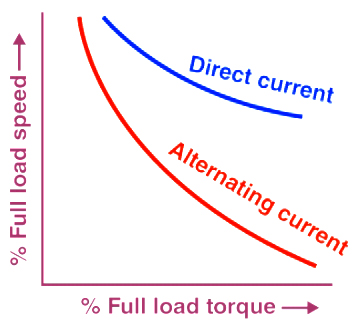A motor that can be operated on both AC and DC supply at the rated voltage is called a universal motor. Basically, the universal motor is an AC series motor. It is just an improved form of a DC series motor. The core size of a universal motor is more than the core size of a DC series motor of the same rating.
Construction of Universal Motor
The universal motor is constructed in the same way as a series-wound DC motor. However, it is designed to operate with either AC or DC applied. The series-wound motor is the only type of DC motor that will operate with AC applied.

Stator
It is the stationary part of the motor. It consists of a magnetic frame (or yoke), pole core, and pole shoe and field or exciting winding. The magnetic frame, pole core, and pole shoe are made of silicon steel stampings. These stampings are insulated from each other by a varnish layer. The hysteresis losses are very small in silicon steel, and eddy current losses are reduced due to stampings. The field winding made of enameled copper is wound around the poles to produce the required flux.
Rotor
It is the rotating part of the motor. It consists of shaft, armature, armature winding, and commutator. A shaft is a part of the rotor which transfers mechanical power or energy to the load. It is made up of mild steel. The armature is made up of stampings of silicon steel material since it carries the magnetic field. It is attached to the shaft. The universal motor’s rotary armature is made of straight or skewed slots on which the commutator and brushes rest.
Working Principle of Universal Motor
When a current-carrying conductor is placed in the magnetic field, a force is exerted on it and torque develops. In other words, when the rotor field produced by the rotor current-carrying conductors, tries to come in line with the main field, torque develops, and the rotor rotates.

In universal Motor both the armature winding and field winding is connected in series. When a DC voltage is applied to the motor, the same current flows through the stator and rotor coils. The magnetic fields around the winding interact and develop torque to turn the rotor. The direction it turns is determined by the direction the current flows through both sets of windings.
When an AC voltage is applied, the direction of the current will alternate. Since the current reverses in both the rotor and stator at the same time, the magnetic fields around both windings also change simultaneously. The result is that the interaction of the two fields causes the direction of the developed torque to remain the same. Therefore, the rotor turns one way, regardless of which direction the applied current flows.
Performance Comparision of Universal Motor in AC and DC Supply
DC Supply: It works just like a DC motor. It has commutator rings that allow unidirectional current is made to flow through the coil and make the torque action unidirectional and the rotor continues to rotate.
AC Supply: When the motor is operated on DC, the current is limited by resistance only, but in AC operation, the current is opposed by impedance which is built up of resistive and reactive components. During AC operation of the universal motor, the inductive reactance of the armature and field windings opposes the current. In effect, a reactance voltage is produced in both the armature and field windings, consuming some of the applied voltage. Consequently, the speed of an AC series motor is less than that of the identical DC series motor.
In a universal motor, the third set of coils called compensating windings is connected in series with the rotor and stator. These windings perform two functions: They correct the neutral plane position that is distorted by armature reaction, and they compensate for undesirable reactive voltages attributed to the inductance of the armature.
Types of Universal Motor
Universal motors are manufactured in two types.
- Concentrated-pole, non-compensated
- Distributed-field compensated
Non-Compensated Universal Motor: The non-compensated motor has two salient poles similar to 2-pole series d.c. motor except for that whole of its magnetic path is laminated. The laminated stator is necessary because the flux is alternating when the motor is operated from a.c. supply. The armature is of wound type and similar to that of a small d.c. motor. It consists essentially of a laminated core having either straight or skewed slots and a commutator to which the leads of the armature winding are connected.
Compensated Type through Distributed Field: The distributed-field compensated type motor has a stator core similar to that of a split-phase motor and a wound armature similar to that of a small d.c. motor. The compensating winding is used to reduce the reactance voltage present in the armature when the motor runs on a.c. supply. This voltage is caused by the alternating flux by transformer action.
Universal Motor Speed
The speed of a universal motor is determined by the following factors:
- A change in the applied voltage. As the voltage increases, the current rises to create a stronger magnetic field, which causes the speed to increase.
- A change in the load. As the physical load, the motor is driving becomes harder to turn, the speed decreases.
- A change in frequency of the power supply. As the frequency increases, the inductive reactance of the series coil rises, which causes current flow through both the field and armature windings to decrease. The result is that the magnetic fields around them become weaker, creating a weaker torque, and the motor slows down.
The no-load speed is quite high, but seldom high enough to damage the motor, as is the case with larger DC series motors. When a load is placed on the motor, the speed decreases and continues to decrease as the load increases.
Speed Regulation of Universal Motor
Two methods commonly used for speed control of the universal motor are as follows:
Resistance Control: By inserting a variable resistor in series with the field coil and armature the voltage across them can be changed. An application example 1s a sewing machine. Its speed 1s varied by a foot pedal, which contains a variable resistor. Another example is a variable-speed hand drill. As the trigger is pulled, resistance in series with the motor is changed to vary the RPM.

Tapping field Method: By tapping a field coil at various points, different inductive reactance values are developed. When the switch is set at the low-speed position, the entire winding is used and the maximum inductive reactance forms and causes minimum current to flow. At the high-speed position setting, the entire coil is bypassed and the inductive reactance is reduced, causing a higher current to flow. An application example of this principle is a blender. A different field pole connection is made for each speed position setting.

Speed Torque Characteristics of Universal Motor
The characteristics of the universal motors are very much similar to those of DC series motors, but the series motor develops less torque when operating from an AC supply than when working from an equivalent DC supply. The speed-torque characteristic of a universal motor is as shown in the figure.

Reversal of roatation
The direction of rotation can be reversed by changing the connections to either the field coil or the armature, but not both. In actual practice, only the armature connections are interchanged.
Characteristics of Universal Motor
- It has high starting torque.
- The no-load speed is very high, but not high enough to break apart.
- It has poor speed regulation when the load to which it is connected changes. To minimize the effect of the load, most universal motors are designed to overcome this by operating at a very high speed of 3500 RPM or greater. In a router application, for example, the universal motor runs at 18,000 RPM.
Applications of Universal Motor
Universal motors are used in many portable applications that require high horsepower for the size. A few examples are vacuum cleaners, polishers, hedge trimmers, circular saws, and mixers.
- These motors are applicable where the control of speed & the motor speed high values are required.
- They are used in handy drill machines, hairdryers, table fans, and grinders.
- This motor is used in polishers, kitchen appliances, and blowers.
- The higher rating motors are applicable in blenders and portable drills.
Fault in Universal Motor
One of the most frequent malfunctions encountered with universal motors is worn-out brushes. They typically require replacement after 300 to 1000 hours of use. Another fault that develops is shorted armature windings, which occur when excessive currents break down the insulation of the armature wire when the motor is overloaded.
Efficiency of Universal Motor
The efficiency of smaller universal motors is around 30%, while the larger universal motors have an efficiency of 70-75%.
Advantages of Universal Motor
The advantages of the universal motor are
- High starting torque.
- The universal motor can be operated from both DC and AC voltage sources.
- Due to the series construction of field winding and armature winding, just like series DC motors, they can rotate at very high speed.
- The universal motor also has the capability to run at adjustable speeds, making it useful for many modern tools demanding speed adjustment.
Disadvantages of Universal Motor
A few downsides to universal motors are that they are noisy, inefficient at low voltages, burnout quickly install conditions, require high maintenance due to the brushes and the open frame design. They also have poor speed regulation, and the high speeds prevent gearbox usage.
- Universal motors have relatively higher noise compared to other AC and DC motors such as induction motors.
- Due to the Presence of carbon brushes, universal motors require frequent service and maintenance.
| Type Of Single Phase Motor | Applications |
| Split phase or resistance motor | Fans, blowers, centrifugal pumps, washing machines, domestic refrigerators, oil burners, etc. |
| Capacitor-start motor | Compressors, conveyors, pumps, fans, centrifugal pumps oil burners, etc. |
| Capacitor start and run motor | Compressors, stockers, conveyors, pumps, high torque and high power factor loads, etc. |
| AC series or universal motor | Portable drills, hairdryers, grinders, table-fans, blowers, polishers, kitchen appliances, etc. |
